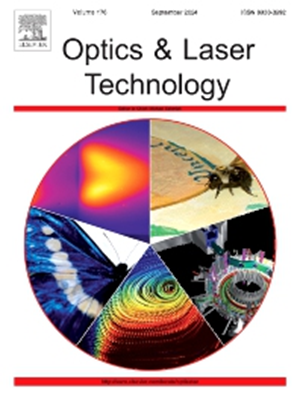Si/Au杂化纳米球中双共振模式的激发与耦合
IF 4.6
2区 物理与天体物理
Q1 OPTICS
引用次数: 0
摘要
混合纳米球(NS)是一种高效的共振耦合纳米平台,在片上集成纳米白源和纳米光子学器件中具有重要的应用。本文将Si/Au杂化纳米粒子作为共振耦合的纳米平台,将Mie共振和表面等离子体共振结合在一起。Si - NS的激发磁偶极子共振(MDR)可以显著提高其白光发射的量子效率。然而,直径较大(d)的Si NS的MDR对应的特征波长将接近或长于吸收极限(~ 1100 nm)。幸运的是,我们发现较大尺寸的Si/Au杂化NS中的电共振耦合可以绕过Si NS在近红外波段的吸收极限和NS的尺寸限制来调制其荧光辐射,为间接带隙硅纳米结构白光源的宽光谱激发开辟了一种新的策略。本文章由计算机程序翻译,如有差异,请以英文原文为准。
Excitation and coupling of dual resonance modes in Si/Au hybrid nanosphere
The hybrid nanosphere (NS) is an efficient resonance-coupled nanoplatform, which has important applications in the integrated on-chip nanoscale white sources and nanophotonics devices. In this paper, the Si/Au hybrid NS is acted as a resonance-coupled nanoplatform to combinate Mie resonance and surface plasmon resonance. The excited magnetic dipole resonance (MDR) of Si NS can significantly enhance its quantum efficiency of white-light emission. However, the characteristic wavelength corresponding to MDR of Si NS with a larger diameter (d) will be close to or longer than the absorption limit (∼1100 nm). Fortunately, it was found that the electric resonance coupling in Si/Au hybrid NS with larger size can circumvent the absorption limit of Si NS at the near-infrared band and size limitation of NS to modulate its fluorescence radiation, exploiting a novel strategy for the wider spectral excitation of indirect band gap silicon nanostructured white light source.
求助全文
通过发布文献求助,成功后即可免费获取论文全文。
去求助
来源期刊
CiteScore
8.50
自引率
10.00%
发文量
1060
审稿时长
3.4 months
期刊介绍:
Optics & Laser Technology aims to provide a vehicle for the publication of a broad range of high quality research and review papers in those fields of scientific and engineering research appertaining to the development and application of the technology of optics and lasers. Papers describing original work in these areas are submitted to rigorous refereeing prior to acceptance for publication.
The scope of Optics & Laser Technology encompasses, but is not restricted to, the following areas:
•development in all types of lasers
•developments in optoelectronic devices and photonics
•developments in new photonics and optical concepts
•developments in conventional optics, optical instruments and components
•techniques of optical metrology, including interferometry and optical fibre sensors
•LIDAR and other non-contact optical measurement techniques, including optical methods in heat and fluid flow
•applications of lasers to materials processing, optical NDT display (including holography) and optical communication
•research and development in the field of laser safety including studies of hazards resulting from the applications of lasers (laser safety, hazards of laser fume)
•developments in optical computing and optical information processing
•developments in new optical materials
•developments in new optical characterization methods and techniques
•developments in quantum optics
•developments in light assisted micro and nanofabrication methods and techniques
•developments in nanophotonics and biophotonics
•developments in imaging processing and systems

 求助内容:
求助内容: 应助结果提醒方式:
应助结果提醒方式:


